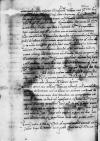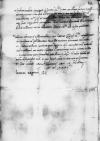Posteaquam negotium ⌊Montis nostri Serici⌋ in ⌊Concilio Collaterali⌋ iam determinatum sit, nempe sententia contra nos lata, quam indubie exspectavimus, semper enim officiales illi huc intenti sunt, ut pro fisco omnia decernant cum iniuria nostra et rerum nostrarum incommodo, quibus semper infensi sunt, visum est ⌊sacrae maiestati regiae⌋, domino et coniugi nostro colendissimo, et nobis ipsis, ut iam tandem ex ea diuturna legatione longaque peregrinatione Strenuitas
Tua redeat sana et felix, quemadmodum ex litteris sacrae maiestatis regiae intelliget Strenuitas
Tua. Et quia superioribus litteris suis scripserat nobis Strenuitas
Tua magnificum ⌊Cornelium Dupplicium Sceperum⌋ negotia nostra in Tuae Strenuitatis
absentia libenter velle curare et agere apud ⌊sacram caesaream et catholicam maiestatem⌋, habitis a nobis singulis annis ducentis ducatis auri, placet id ⌊sacrae maiestati regiae⌋ et nobis volumusque, ut iam illum in locum suum substituat agentem sacrae ⌊regiae maiestatis⌋ et nostrum regni et Barensium negotiorum, quae illi aperiat ac de omnibus singillatim eum informet et instructionem illi relinquat admoneatque, ut fideliter et integre ac diligenter negotia huiusmodi regia et nostra curet et promoveat, habiturus a nobis ducatos ducentos auri quotannis, quamdiu negotia ipsa curaverit, quo cum statuat, ubi de illis respondendum sit ei, an apud ⌊Fucaros⌋ aut ⌊Velseros⌋ et an simul et semel in anno vel ad certa anni tempora seu ratas.
Promiserat autem Strenuitas
Tua in discessu suo ⌊Montem hunc nostrum Sericum⌋ se apud ⌊sacram caesaream maiestatem⌋ facile impetraturum, etiam si in ⌊Concilio Collaterali⌋ contra nos sententia lata fuisset, id enim sacra maiestas caesarea Tuae Strenuitati
pollicebatur. Qua de re noluimus ulterius appellare. Maluimus rem ipsam in gratiam ⌊suae caesareae maiestatis⌋ remittere, quae, iustitia et meritis nostris exigentibus, nobis merito relaxari debet. Iustitia, diximus, quandoquidem omnes
vicini incolae passim testantur et iudicialiter testati sunt illustrissimam bonae memoriae ⌊matrem⌋ nostram nihil umquam alieni usurpavisse et ut illa possidebat pacifice, ita nos aliquanto tempore possidebamus citra omne praeiudicium fisci regii et cuiusvis alterius. Quanta autem sint merita et illustrissimae ⌊matris⌋ nostrae et nostra erga illius ⌊sacram caesaream maiestatem⌋ et rempublicam ⌊regni Neapolitani⌋, nemo est, qui nesciat. Nam, ut ⌊matrem⌋ nostram omittamus, in hoc transacto bello et ⌊statum nostrum Barensem⌋ ab exercitibus ⌊serenissimi regis Galliae⌋ defendimus et alias civitates recuperavimus ac praeter id ultra triginta milia ducatorum pro defensione ⌊reipublicae Neapolitanae⌋ ex statu nostro solvimus et intra trium annorum decursum adhuc sex milia soluturae sumus pluraque alia sunt servitia nostra et merita pro nostra sanguinis, fidei et amoris erga ⌊sacram illius maiestatem caesaream⌋ coniunctione exhibita, quae longum esset enumerare, et tamen deterioris condicionis aestimamur, quam fuerat illustrissima ⌊dux⌋, mater nostra, quae ab ⌊avo⌋ suae maiestatis large pro servitiis suis fuera[t] remunerata. His itaque in medium adductis rogabit diligentissime illius sacram maiestatem caesaream, ut gratiam promissam nobiscum faciat, ⌊Montem Sericum⌋ nostrum nobis redintegrari et relaxari dignetur.
Meminerit item Strenuitas
Tua dohanae ⌊Trani⌋ aut ⌊Monopoli⌋ vel summae illorum rebellium declaratorum. Sed res alienas non ambimus, mallemus dohanas istas, licet non magni etiam sint valoris. Non agimus tantum pro commodo, quantum ut aemuli nostri cognoscant ⌊sacram caesaream maiestatem⌋ pro nostri sanguinis et amicitiae coniunctione ⌊sacrae maiestati regiae⌋ et nobis propensam esse. Ea, utpote in comparatione meritorum nostrorum paucissima, facile nobis adici possunt. Haec si nobis attulerit Strenuitas
Tua, uti bene speramus, adventus eius, diu exspectatus, multo nobis gratior erit.
Priusquam autem Strenuitas Tua discesserit, ad unguem exploret, quomodo res su[as] habeat ⌊Scipio de Summa⌋, an in gratia ⌊caesaris⌋ nec ne et si cum offic[io]
in ⌊Italiam⌋ redibit. Inter[ro]get ⌊caesaream maiestatem⌋ Strenuitas Tua, an illum diutius in officio, cui praeerat, ultra pati debeamus. Scit enim Strenuitas Tua nos habere litteras mandati ⌊suae maiestatis caesareae⌋, ut eum in officio habere non debeamus, quare neque hunc, neque alium quempiam etiam maioris dignitatis et auctoritatis habere vellemus contra voluntatem ⌊illius sacrae maiestatis⌋, nec ipsum patiemur.
Praeterea obtineat et afferat nobis Strenuitas Tua litteras ⌊caesareae maiestatis⌋, ut non quat[tuor] personas ad castellanatum Barensem nominare debeamus, sed unam [ad pla]citum nostrum, quotiens opus fuerit, si iste moreretur, vel eum de[ponere] vellemus, nos autem eligemus et nominabimus talem virum in ⌊re[gno Ne]apolitano⌋ possessionatum, qui ⌊illius sacrae maiestati⌋ et nobis fidelis et m[ulto] obsequentior erit, in quo faciet nobis Strenuitas Tua rem pergratam.
Et bene valeat.



